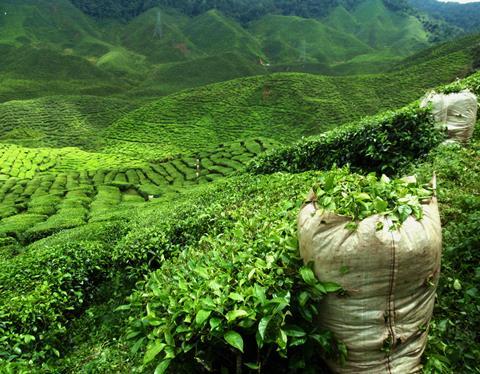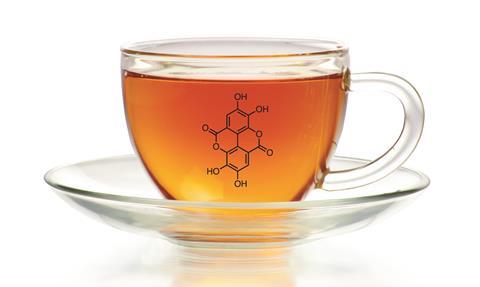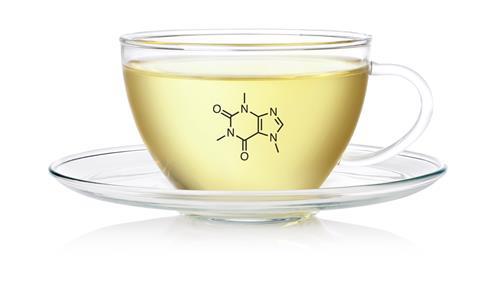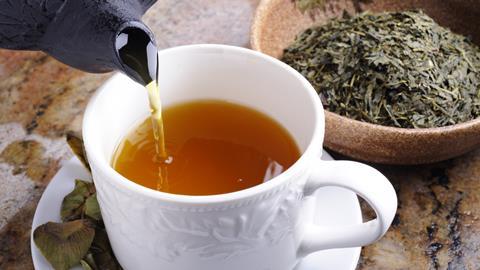Katrina Megget finds there’s more to tea than just a great brew – it’s also chemically complex
‘Now I’m going to teach you how to slurp,’ says Kathryn Sinclair, senior brand ambassador at British tea firm Twinings. ‘We taste from the olfactory glands and we need to open these up, so breathe in through the mouth, breathe out through the mouth and slurp.’ She noisily sucks up the pale-coloured liquid using a soup spoon. I try the same, experiencing a slightly sweet and fresh floral taste. This is tea number one – white tea – in the Twinings tea master class held at the company’s 300-year old shop on the Strand in London. Sinclair notes that white tea is a young leaf that is rich in antioxidants and which has the highest caffeine content out of all the tea types because it is the least processed. ‘White tea is the purest form of tea,’ she explains.
After slurping the white tea comes yellow tea, a rare and grassily fragrant tea only grown in four plantations in the world, all of which are in China. Next is the artisan green tea. This one from Japan has been processed by hand and has a slight tang of seaweed. We then enjoy a slurp of oolong before we try black tea (what tea-drinkers outside Asia would consider ‘normal’ tea) and then finally the microbially fermented pu’erh tea with its dark colour, strong taste and earthy smell.

Sinclair explains that each tea is different depending on its country of origin and the conditions it grows in. Chinese tea comes from the Camellia sinensis variety sinensis plant, which is more bush-like and prefers cooler temperature, often at higher altitudes. Indian tea from the Assam region comes from the Camellia sinensis variety assamica plant, which can be a tall tree, up to five metres in height, that prefers a flatter geography and hot, humid conditions. Everything from soil, temperature, humidity, sunlight and rainfall will influence the quality and taste. ‘Tea is very susceptible to the environment. It needs optimal conditions to survive,’ she says.
Ultimately, however, the differences in tea types come down to chemistry, and this chemistry is influenced by cultivation, environment, weather and, importantly, processing. ‘From the chemistry perspective, tea is the ultimate mystery and challenge to food and analytical chemists,’ says Nikolai Kuhnert, a chemist at Jacobs University in Bremen, Germany. ‘No food material is more fascinating and chemically diverse and complex.’
Packed with compounds
The tea leaf itself is packed with different compounds, the main ones being polyphenols, which can be up to 40% of the dry weight of the leaf. There are also amino acids, enzymes, methylxanthines such as caffeine, minerals and vitamins and more than 700 aroma compounds in trace amounts.

Polyphenols – also known as tannins – are by far the largest group of compounds in tea. In a cup of tea, they largely provide astringency, that dry-mouth feeling after a drink, while also providing some colour and flavour. They are believed to have disease-busting antioxidant properties. A strong cuppa can have as much as 240mg of polyphenols.
The most important group of polyphenols in tea are the flavonoids, featuring flavanols that include a variety of catechins, with epigallocatechin gallate being widely studied for its health benefits. Much of the flavour and colour of a cup of tea results from the two phenolic substances theaflavins and thearubigins, which are formed from flavanols during tea processing. There is limited knowledge about these compounds but much research is being done. Other types of flavonoids, such as flavones and anthocyanins, are also found in tea.
Besides the health-boosting antioxidants, tea is well known for its stimulant properties from caffeine, which leaves contain at levels between 1% and 6% of dry weight. Theobromine and theophylline are two compounds similar to caffeine, and these three methylxanthines contribute to the bitter taste in tea. The caffeine content in a cup of tea ranges between 20 to 70mg per 170ml from around 2.5g of tea leaves, but strongly depends on infusion time and the type of tea. A cup of coffee, in comparison, has 40–155mg of caffeine per 170ml.

But caffeine is not the only psychoactive compound in tea – the amino acid theanine comprises about 1% of tea’s dry weight. What is unique to tea, says Nigel Melican, managing director of tea consultancy firm Teacraft, is that caffeine and theanine together have the ‘synergistic and balancing effect of stimulating and relaxing’. Where caffeine stimulates and wards off drowsiness, theanine induces a relaxed alertness that reduces mental anxiety and creates a sense of wellbeing by increasing the brain’s production of gamma-amino butyric acid and promoting alpha brainwave activity. ‘This is why theanine balances the excitation caused by caffeine,’ Melican says. The amino acid also improves the taste of tea by offsetting the astringency of some brews, he adds.
Modern analytical techniques, such as high-resolution mass spectrometry, have allowed the chemical nature of many tea compounds to be elucidated, says Kuhnert. Indeed, green tea has been quite heavily studied. But tea remains complex with many unknowns, particularly the chemistry during processing to make black tea. For instance, many of the volatile aromatic compounds, responsible for flavour and aroma, do not exist in fresh tea leaves and only occur through processing. ‘Black tea has hardly been studied by life scientists due to its complexity and a lack of knowledge of its composition,’ says Kuhnert. ‘In black tea there are around 30,000 molecules formed during fermentation [oxidation] and only a handful have been studied.’
Making tea
It’s the processing of tea that makes the chemistry intriguing. Fermentation is often used to describe the process of making tea, but it is essentially an oxidation process: the polyphenols are exposed to oxygen and oxidase enzymes, which convert the polyphenols into theaflavins and thearubigins. Oxidation occurs after the leaves have been picked and the cell walls are mechanically broken after wilting (or withering). This mixes catechins and enzymes, resulting in the enzymatic browning of the leaves and the development of new taste and aroma profiles.

The beauty of tea is that this oxidation process can be manipulated and controlled to change the appearance, aroma, flavour and taste, which results in different types of tea with different chemical components. By applying heat, for instance, the oxidation process is hindered by inactivating the enzymes. ‘How and if the chemicals change or mix with each other depends entirely on the process conditions we apply and levels of these, and the duration and sequence we use,’ says Melican.
For instance, variations in processing condition and technique can change the tea and its chemical constituents, explains A K Barooah, director of the Tocklai Tea Research Association, in India. There are two types of maceration technique – orthodox and CTC, which produce different chemical constituents, he says. Orthodox teas are usually harvested and processed by hand, with a focus on whole leaves, while CTC teas (standing for crush, tear, curl) are passed through a machine with sharp teeth, which essentially minces the leaf. ‘Orthodox tea is more flavoured and less coloured, while CTC tea produces a very strong coloured liquor with a mild flavour,’ explains Barooah. Orthodox teas are often considered higher quality and, therefore, more expensive than CTC teas. Tea bags, for instance, contain the dust or fannings – the smallest low-grade particles that don’t catch a high price.
The main difference between tea types is largely based on the level of oxidation. Black teas, for instance, are fully oxidised. The leaves are first allowed to wither and then they are ‘rolled’, which involves rubbing or crushing the leaves to release the chemicals to begin oxidation. The leaves are then left to oxidise in a temperature- and humidity-controlled room, turning completely brown before being dried. Because of this process, black tea has fewer green catechin polyphenols than other tea types but it contains up to 20% thearubigins and around 2% theaflavins, which are formed during oxidation. Meanwhile, bisflavanols are formed from flavanols, which have undergone polyphenol oxidative polymerisation.
Green teas, on the other hand, are not oxidised, because heat is applied – generally through steaming or pan firing – very soon after harvesting. As a result the green catechins are not oxidised and the colour of the leaf is preserved. Yellow and white teas are also subject to very little oxidation, and these three teas all contain higher levels of polyphenols than black tea, with the percentage similar to that of the fresh tea leaf. The main bulk of polyphenols in green tea are catechins, making up about 30-42%, while about 3.5% of a green tea cuppa is caffeine.
Oolong teas are partly oxidised during withering; so shortly after rolling, the leaves are fired to stop the oxidation process. Because of the limited amount of oxidation, oolong tea – like green, white and yellow – has a higher polyphenol content than black tea. Oolong also contains a unique flavonoid called oolonghomobisflavins and also has variable amounts of catechins and thearubigins depending on the degree of oxidation applied by the tea maker.
Chemistry in the kitchen
The production of tea involves no other reagents or compounds. ‘During processing, nothing is added and only water is taken away,’ says Melican. ‘Tea is one of the most pure foods that pass our lips.’ Once tea has been produced, however, a whole variety of additional activities can occur, from the production of blends (think Earl Grey and English Breakfast) to added flavours like apple or orange.
These post-production processes don’t change the chemistry; that happens in the kitchen. For instance steeping (i.e. brewing) time and temperature can impact the compounds in your cup. When hot water is added to tea, the tea phenolics are extracted into the aqueous phase along with other tea chemicals, explains Kuhnert, who is currently exploring the changes in chemical composition during the brewing process. ‘Caffeine is extracted first, then the phenolics. At high temperatures, certain highly bitter and astringent phenolics are extracted first. So to have a less bitter brew a lower temperature is recommended,’ he says.

Polyphenols can degrade and disappear during steeping in hot water, says Shiming Li, visiting research professor at Rutgers University in the US. This was seen in research published last year, where researchers from the University of Malaya studied antioxidant properties in white, green and black tea and found that the most effective steeping temperature and time was dependent on tea type. Black tea, for instance, had higher antioxidants in a short hot water infusion but when steeped for a longer time antioxidant activity was reduced. Whereas white tea was found to have more antioxidants the longer it was brewed, and green tea was temperature sensitive.
A variety of other studies have found that longer infusion times lead to tea cup liquors with a higher caffeine content, while the polyphenols that take longer to diffuse (highly polymerised thearubigins) are the ones that give tea the unpleasant stewed taste when it has been brewed for too long. Meanwhile, smaller sized tea leaves, for example those found in tea bags, diffuse more rapidly and tend to have a stronger flavour than large leaf tea.
In the UK, many people add milk to their tea. There is conflicting research on what happens chemically. Barooah says the proteins in milk can form complexes with the tea polyphenols, and some experts believe this may prevent the antioxidant health benefits by decreasing the bioavailability of polyphenols. A 2010 study by researchers Lisa Ryan and Sebastien Petit at Oxford Brookes University in the UK explored this concept with different types and volumes of milk. They found that skimmed milk decreased the total antioxidant capacity of tea significantly more than either whole or semi-skimmed milk, both of which also decreased antioxidant capacity. The researchers concluded that black tea is a valuable source of antioxidants and that the effect of milk on the total antioxidant capacity may be related to the fat content of the milk.
Drink for your health
Some of the most exciting scientific developments have been around understanding the biochemical mechanism of tea processing, says Barooah, and this, in turn, has spearheaded research looking at the health benefits of tea. ‘Tea can be considered a functional food due to its high antioxidant value,’ says Barooah. ‘The catechins, theaflavins, thearubigins and polysaccharides present in tea are found to have medicinal value, and the most exciting findings on health aspects are due to tea’s anti-carcinogenic, anti-diabetic and anti-hypertension activity.’
Indeed, there are a number of studies that suggest tea has potential health benefits including a reduced risk of coronary heart disease, stroke, inflammatory diseases, osteoporosis and cancer, as well as beneficial effects on the gastrointestinal tract, and even antiviral properties. For instance, in January this year, scientists from the Wuyishan Municipal Hospital in China discovered that regular consumers of tea – drinking more than 10g of tea every day for six years or more – had the lowest cases of arterial wall thickening and loss of elasticity across four groups of tea drinkers – regular tea drinkers for 10 years, drinkers for six to 10 years, one to five years and non-habitual drinkers – thereby reducing the risk of heart disease. Catechins are believed to deliver the health benefits, the scientists said.
Green tea, with its high levels of catechins, is of particular scientific interest and there is currently a lot of focus on epigollocatechin gallate. Earlier this year, Brazilian researchers found that high concentrations of the chemical in vitro prevented more than 90% of the zika virus from entering cells. Meanwhile, in black tea, theaflavins are the chemicals of interest with their antioxidant and anti-inflammatory effects.
Li of Rutgers University was previously head of analytical and natural product chemistry at WellGen, a biotech company focusing on medical foods. During his tenure, he was part of the team producing a black tea health product containing 40% theaflavins. ‘For thousands of years, drinking tea has been a tradition and research now shows efficacious health benefits. It is also readily available and recognisable, and has minimal side effects versus drugs,’ he says. Indeed, he believes tea as a medical food could have a future, with broad applications including high-polyphenol ready-to-drink tea beverages and in replacing artificial antioxidants and preservatives in the edible oils that end up in food products.
However, more research is required into the specific health properties of tea and its chemicals. There are concerns around the health impact of caffeine and, as yet, the US Food and Drug Administration has been slow to recognise the benefits of tea, Melican says. ‘Personally, I drink nearly a quart of tea a day. I am 75 years old, healthy, active and still work a 50-hour week – so there may be something in it.’
Drinking tea has been popular for millennia. Slowly the science is starting to reveal the complex chemical nature of our favourite brew. ‘In the Hitchhikers Guide to the Galaxy, the Nutri Matic drink dispenser is unable to provide Arthur Dent with a good cup of tea. Now the science can explain why,’ says Kuhnert: ‘It’s just too complicated.’
Katrina Megget is a science writer based in London, UK













No comments yet